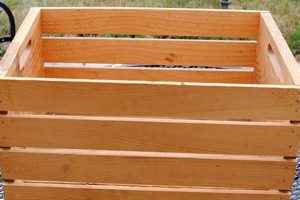A self-constructed wooden container designed to maintain a cool internal temperature. These units often utilize insulation and ice to preserve beverages and food items at desired temperatures for extended periods. A typical example involves repurposing reclaimed lumber to build a box, lining it with a waterproof material, and including a drainage system for melted ice.
The construction of a cooling unit offers economic advantages by reducing reliance on commercially manufactured products. This approach also provides customization options, allowing individuals to tailor the size, appearance, and features to meet specific needs and preferences. Historically, similar methods using natural materials like wood and ice have been employed for food preservation prior to the advent of modern refrigeration.
The subsequent sections will delve into the materials required for this project, the steps involved in the assembly process, and potential design modifications to enhance functionality and aesthetic appeal. Detailed considerations regarding insulation techniques and drainage solutions will also be provided.
Essential Considerations for Wood Cooler Construction
This section outlines critical factors to ensure a durable, functional, and aesthetically pleasing outcome when building a wooden cooler.
Tip 1: Wood Selection: Prioritize rot-resistant wood types such as cedar, redwood, or treated lumber. This selection mitigates degradation from moisture exposure, extending the structure’s lifespan.
Tip 2: Insulation Implementation: Employ closed-cell foam insulation for optimal thermal performance. Ensure complete coverage of all interior surfaces to minimize heat transfer.
Tip 3: Waterproof Liner Installation: Use a heavy-duty, food-grade plastic liner or a fiberglass coating to create a watertight seal. Proper sealing prevents water damage to the wood and maintains hygiene.
Tip 4: Drainage System Integration: Incorporate a sloped base within the cooler and install a drain valve at the lowest point. This facilitates efficient removal of melted ice water.
Tip 5: Hardware Considerations: Select corrosion-resistant hardware, such as stainless steel screws and hinges. This precaution prevents rust and maintains structural integrity.
Tip 6: Lid Design and Sealing: Design a tight-fitting lid with a gasket or seal to minimize air exchange. A secure lid is critical for effective temperature regulation.
Tip 7: Finish Application: Apply a protective exterior finish, such as a marine-grade varnish or exterior paint. The finish should shield the wood from UV radiation and moisture.
Adhering to these guidelines ensures a reliable and long-lasting cooling solution. Proper material selection, insulation, and drainage are essential for optimal performance.
The concluding section will summarize the construction process and highlight potential applications for the finished product.
1. Wood Durability
Wood durability is a critical determinant of a self-constructed cooling unit’s lifespan and performance. The material’s inherent resistance to rot, decay, and insect infestation directly influences the structural integrity of the enclosure and its capacity to withstand prolonged exposure to moisture and temperature fluctuations. Failure to select a durable wood species or appropriately treat a less durable species results in premature degradation, compromising the cooler’s insulating properties and necessitating repairs or replacement. For instance, a cooler constructed from untreated pine, when repeatedly exposed to moisture from melting ice, will exhibit accelerated decay compared to a cooler built from naturally resistant cedar or redwood. The selection of wood becomes a fundamental engineering consideration.
The practical significance of understanding wood durability lies in preventing costly and time-consuming maintenance. Furthermore, the choice impacts the long-term effectiveness of the cooler as an insulated container. Compromised wood loses its structural rigidity, leading to gaps and diminished insulation capabilities. To illustrate, a cooler with warped or decaying wood will exhibit reduced ice retention times, rendering it less effective for prolonged cooling. Proper wood selection acts as a preventative measure against these performance deficits.
In summary, prioritizing wood durability is essential for the long-term functionality and value of a self-made wooden cooler. Selecting appropriate wood species or applying preservative treatments are necessary steps for mitigating environmental damage and ensuring a sustained service life. The correlation between wood durability and overall cooler performance underscores the importance of informed material selection in the construction process. This ensures structural integrity and functional longevity.
2. Effective Insulation
Effective insulation is paramount in the construction of a cooling unit, directly influencing its ability to maintain low internal temperatures and preserve the contents within. Without adequate insulation, heat transfer from the external environment rapidly increases the internal temperature, negating the cooling effects of ice or other refrigerants.
- Material Selection for Insulation
The choice of insulating material significantly impacts the cooling unit’s performance. Closed-cell foam, such as expanded polystyrene (EPS) or polyurethane, offers high insulation values and resistance to moisture absorption. These materials inhibit conductive and convective heat transfer. In contrast, open-cell foams or fibrous materials are less effective due to their higher thermal conductivity and susceptibility to moisture accumulation, reducing their insulating capacity.
- Insulation Thickness and Coverage
The thickness of the insulation layer is directly proportional to its thermal resistance. Insufficient thickness compromises the cooler’s ability to maintain a stable internal temperature. Moreover, complete coverage of all interior surfaces is essential to eliminate thermal bridging, where heat can bypass the insulation through direct contact between the interior and exterior walls. Gaps or incomplete coverage diminish the overall effectiveness, irrespective of the insulation material used.
- Airtight Sealing of the Insulation Layer
An airtight seal around the insulation is crucial for preventing air infiltration, which can introduce warm air and increase the rate of heat transfer. Gaps or cracks in the insulation layer allow convective currents to develop, accelerating the melting of ice and reducing the cooler’s hold time. Proper sealing with caulk or tape minimizes air leakage and maintains the insulation’s performance.
- Impact of Ambient Temperature
The ambient temperature surrounding the cooling unit directly affects its performance. Higher ambient temperatures increase the rate of heat transfer through the insulation, requiring more frequent replenishment of ice or refrigerants. Conversely, lower ambient temperatures reduce the heat load, extending the cooler’s hold time. Understanding the environmental conditions in which the cooler will be used is essential for selecting appropriate insulation levels.
The integration of effective insulation fundamentally determines the usefulness of a self-constructed cooling unit. The selection of appropriate materials, ensuring adequate thickness and complete coverage, and maintaining an airtight seal are crucial factors for maximizing thermal performance. These elements collectively contribute to the cooler’s ability to maintain low internal temperatures and preserve its contents for extended periods. Therefore, proper implementation of insulation is not merely an accessory but a core requirement for a functional unit.
3. Watertight Liner
The integrity of a self-constructed cooling unit hinges significantly on the presence and effectiveness of a watertight liner. This barrier prevents water from penetrating the wood, thereby mitigating structural damage and ensuring the long-term usability of the cooler.
- Material Selection and Compatibility
The choice of lining material influences both the effectiveness and longevity of the watertight barrier. High-density polyethylene (HDPE) and food-grade plastics are frequently utilized due to their impermeability and resistance to chemical degradation. The selected material must be compatible with wood treatments or adhesives used in the cooler’s construction to prevent delamination or material breakdown. Incompatible combinations can lead to premature failure of the liner, compromising the cooler’s integrity.
- Sealing Techniques and Joint Integrity
Proper sealing of the liner seams and joints is critical for preventing water intrusion. Welding, adhesive bonding, or the use of specialized sealants are common methods. The integrity of these joints must withstand the constant pressure and movement caused by the weight of ice and contents. Failure to properly seal joints results in water seepage, promoting wood rot and potentially contaminating the cooler’s contents.
- Physical Stress and Liner Durability
The watertight liner is subjected to physical stress from the weight of ice and contents, as well as temperature fluctuations. The material’s thickness and flexibility determine its ability to withstand these stresses without tearing or puncturing. Thicker, more durable liners are better suited for heavy-duty use and can prevent damage from sharp objects or irregular surfaces within the cooler. Compromised liner integrity can lead to significant water damage and reduced cooling efficiency.
- Maintenance and Hygiene Considerations
A watertight liner not only protects the wood structure but also facilitates cleaning and sanitation. A smooth, non-porous surface prevents the absorption of odors and the growth of mold or bacteria. Regular cleaning with appropriate disinfectants maintains hygiene and prevents contamination of the cooler’s contents. A damaged or porous liner is difficult to clean and can harbor harmful microorganisms, posing a health risk.
The inclusion of a robust, well-sealed watertight liner directly enhances the performance and extends the lifespan of a self-constructed wooden cooler. The liner’s role in preventing water damage, maintaining hygiene, and withstanding physical stress underscores its importance as a fundamental component of the design.
4. Adequate Drainage
Adequate drainage is a critical factor in the design and construction of a cooling unit. The melting of ice within the cooler produces significant amounts of water, and its accumulation directly affects the cooler’s functionality and longevity. Without a properly implemented drainage system, the collected water saturates the wood, promoting rot, fungal growth, and structural weakening. For instance, a cooler lacking drainage will experience accelerated decay of its wooden components, reducing its lifespan and potentially contaminating its contents. The presence of standing water also diminishes the cooling efficiency as the ice expends energy cooling the water rather than the contents. This exemplifies the direct causal relationship between drainage and overall performance.
The integration of a drainage system, typically involving a sloped internal floor and an external drain valve, facilitates the efficient removal of meltwater. This mitigates moisture-related damage and maintains optimal cooling conditions. The drain valve’s placement at the lowest point allows for complete evacuation of the accumulated liquid. The selection of corrosion-resistant materials for the drain valve is essential to prevent degradation and ensure long-term functionality. Moreover, the design of the drainage system must consider the frequency of use and the expected volume of meltwater, with larger coolers potentially requiring larger drain valves or more frequent drainage cycles. A case in point is a large party cooler, which, if used extensively, might need drainage every few hours to maintain its cooling capacity and prevent waterlogged contents.
In summary, adequate drainage is not merely an optional feature but a fundamental requirement for a durable and efficient self-constructed wooden cooler. The effective removal of meltwater prevents structural damage, maintains cooling efficiency, and ensures hygienic conditions. Challenges related to drainage include selecting appropriate materials, ensuring proper slope and valve placement, and accounting for varying usage patterns. However, addressing these challenges through careful design and execution is crucial for maximizing the cooler’s lifespan and performance.
5. Robust Hardware
Robust hardware components are essential for the structural integrity and operational longevity of a self-constructed wooden cooler. The hardware, including fasteners, hinges, handles, and latches, bears the brunt of mechanical stress, environmental exposure, and repetitive use. Selection of appropriate materials and designs is critical for ensuring the cooler’s durability and functional performance.
- Corrosion Resistance
Fasteners and hinges exposed to moisture from melting ice and external elements are susceptible to corrosion. Stainless steel, brass, or coated hardware is employed to resist rust and maintain structural integrity. The use of non-corrosive hardware prevents weakening of joints and ensures that the cooler remains structurally sound over time. An example includes stainless steel hinges, chosen for their ability to withstand constant exposure to moisture without degradation.
- Load-Bearing Capacity
Handles and latches must withstand the weight of the cooler, particularly when fully loaded with ice and beverages. The hardware’s load-bearing capacity should exceed the maximum expected weight to prevent failure under stress. Reinforced handles and heavy-duty latches are utilized to ensure secure transport and prevent accidental opening. Consider a reinforced steel handle, designed to bear the weight of a full cooler during transport, preventing breakage and potential injury.
- Joint Stability and Fastening
The method of fastening wood components significantly impacts the cooler’s overall stability. Screws, bolts, or specialized fasteners provide secure connections that resist loosening over time. Adhesive alone is insufficient for structural joints that bear significant loads. Proper fastening techniques distribute stress and prevent warping or separation of wood panels. An example is the use of threaded inserts and machine screws to create a robust connection for attaching handles, resisting pull-out forces.
- Seal Integrity and Closure Mechanisms
Latches and closure mechanisms are crucial for maintaining a tight seal, minimizing air exchange, and preserving cooling efficiency. Adjustable latches, compression latches, or magnetic closures provide a secure and reliable seal. The selected mechanism should be easy to operate and resistant to accidental opening. Imagine a compression latch system ensuring a tight lid seal, crucial for minimizing heat transfer and maintaining low internal temperatures.
The selection and implementation of robust hardware directly contribute to the functional reliability and extended service life of a wooden cooler. Choosing appropriate materials, ensuring adequate load-bearing capacity, and employing secure fastening techniques are essential for maximizing the cooler’s performance. By prioritizing robust hardware, the overall value and durability of the self-constructed cooling unit are enhanced. It is important that the chosen components suit specific design needs.
Frequently Asked Questions
The following addresses common inquiries regarding the construction and maintenance of cooling units, providing concise and informative answers.
Question 1: What types of wood are most suitable for this purpose?
Woods exhibiting natural resistance to decay, such as cedar, redwood, and cypress, are preferred. Pressure-treated lumber provides an alternative but requires careful consideration due to potential chemical leaching.
Question 2: What is the recommended insulation material?
Closed-cell foam insulation, including expanded polystyrene (EPS) and polyurethane, offers high thermal resistance and moisture impermeability. Fiberglass batting is generally unsuitable due to moisture absorption.
Question 3: How should the interior liner be installed to ensure a watertight seal?
The liner must be precisely cut and fitted to the interior dimensions of the cooler. Seams should be overlapped and sealed with a waterproof adhesive or heat-welded to prevent water penetration.
Question 4: What type of drainage system is most effective?
A sloped floor leading to a drain valve positioned at the lowest point allows for complete water removal. The drain valve should be constructed of corrosion-resistant material, such as stainless steel or brass.
Question 5: What precautions should be taken to prevent mold growth?
Maintaining a dry interior is crucial. Regular cleaning with a mild bleach solution can inhibit mold growth. Ensuring adequate ventilation when the cooler is not in use is also beneficial.
Question 6: How can the cooler’s cooling efficiency be maximized?
Pre-cooling the cooler prior to use, using ice packs in addition to loose ice, and minimizing the frequency of lid openings can improve cooling efficiency. Placement in a shaded area also reduces heat gain.
The above guidelines should assist in the creation and upkeep of a reliable and efficient cooling apparatus.
The subsequent section will summarize the complete construction procedure and outline potential applications.
Conclusion
The preceding exploration of diy wood cooler construction has emphasized critical aspects of material selection, design, and implementation. The effectiveness and longevity of such a project depend significantly on the proper choice of wood, the implementation of robust insulation and a watertight liner, and the provision of adequate drainage. Furthermore, the utilization of durable hardware is essential for structural integrity and operational reliability. These elements, when meticulously addressed, contribute to a functional and sustainable cooling solution.
The knowledge presented empowers individuals to create a customized cooling unit tailored to specific needs, circumventing the limitations of commercially manufactured products. By understanding the principles outlined, one can achieve a higher degree of control over material sourcing, construction methods, and overall design, leading to a more durable and efficient product. The pursuit of such projects offers an opportunity to integrate practical skills with sustainable practices, resulting in a tangible and enduring asset.







